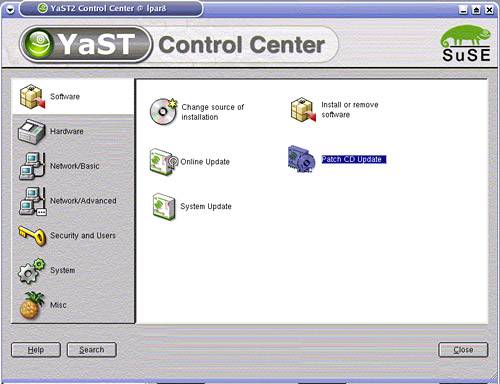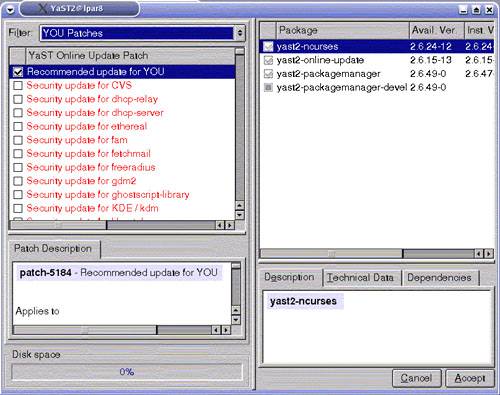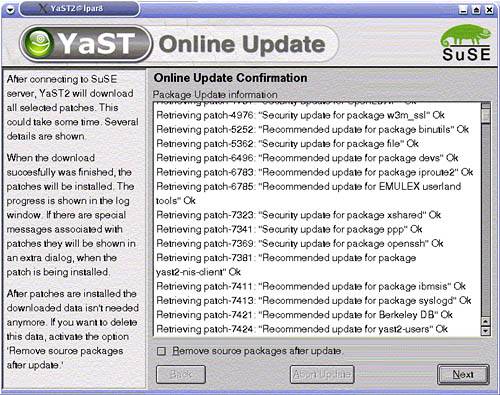2.5 Post-installation tasks
| < Day Day Up > |
2.5 Post-installation tasksAt this point, we have installed the Linux operating system on our system and defined at least one network interface, and can access it remotely. Before customizing the system and making it available to our user community (developers, database administrators, Web administrators, computer scientists), we may need to perform a few other tasks such as checking the installation and applying patches. We describe these tasks in the following sections. 2.5.1 Checking the installationSLES 8 provides a tool called hwinfo that will list all the hardware it finds. It is useful to check this list against your expectations, for example, the number and speed of the processors, memory configuration, and I/O adapters. The output of hwinfo is very detailed. For I/O adapters, lspci can also be used; it is available under SLES 8 and RHAS 3. 2.5.2 Applying SLES 8 patchesSLES 8 and RHAS 3 each offer an automatic update facility, usually through an Internet connection to their respective support Web sites. This process is documented in 3.10, "System updates" on page 139. What we describe here are the steps to apply a patch CD to a newly installed SLES 8 distribution. Service Packs (SPs) are patch CDs that consolidate in one media a whole set of individual patches known to work together. To apply these patches, use the yast2 command. We assume that you have installed the default system. However, if you only installed the minimal system, only the curses version of yast2 is available. There is nothing wrong with this but the screens will obviously be different from the ones we show here. Using the command yast2 , you arrive at the screen shown in Figure 2-40 on page 89. Figure 2-40. SLES 8 software update Choose the Patch CD update option. You can then choose to back up the current system before proceeding. This "backup", as well as the contents of the /etc/sysconfig directory, is saved under /var/adm/backup/rpmdb in the RPM database. Once this backup is finished, you are presented with the update screen shown in Figure 2-41 on page 90. In our case, the SP3 CD was NFS-mounted under /mnt, thus the choice for the installation source. Figure 2-41. Online update welcome screen The next step will update YaST itself and terminate the update process. You will be asked to restart YaST2 again to actually perform the rest of the update. The first step is shown in Figure 2-42 on page 91. Figure 2-42. Update the updater first! Once this update finishes, we restart the whole process from the beginning. This time, we arrive at the screen showing all patches ready for installation; see Figure 2-43 on page 92. Figure 2-43. List of software updates to apply Applying all the patches takes a while. You can follow the update progress as shown in Figure 2-44 on page 93. Figure 2-44. Monitoring the update progress You will need to reboot after the update if the kernel was updated too, which is very likely. 2.5.3 Where to get helpThe primary source for support is the maintenance contract you get when buying SLES 8 or RHAS 3. However, there are also many resources on the Web that you can call upon. General Web sitesThe primary sources of information for kernel- related issues are: http://penguinppc.org http://penguinppc64.org IRC channelsOn irc.freenode.net, these channels are related to Linux on PowerPC:
Mailing listsFor all mailing lists related to Linux on PowerPC, see: http://lists.linuxppc.org/ Lists are also available from: http://lists.penguinppc.org You may also wish to check: http://lists.debian.org/debian-powerpc/ News groupThe primary news group for Linux on PowerPC is located at: http://comp.os.linux.powerpc |
| < Day Day Up > |
EAN: N/A
Pages: 108




